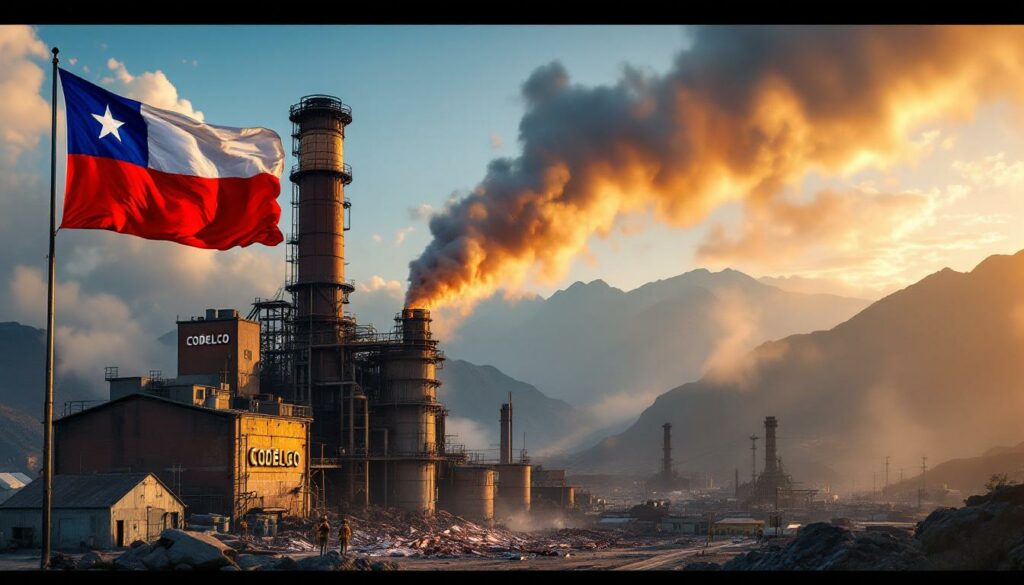Codelco's Potrerillos Smelter Crisis: The Complex Shutdown Debate
The future of Codelco's century-old Potrerillos copper smelter hangs in the balance following a significant structural failure that has reignited internal debates about the facility's viability. With economic, environmental, and socio-political factors all in play, the decision represents a microcosm of the broader challenges facing Chile's copper processing industry and global smelting operations. Recent copper price predictions suggest volatile conditions ahead, adding another layer of complexity to the smelter mishap and shutdown push at Codelco.
What Happened at Codelco's Potrerillos Smelter?
The Recent Chimney Collapse Incident
In June 2025, the Potrerillos smelter experienced a critical infrastructure failure when one of its main chimneys collapsed. This incident wasn't merely a routine maintenance issue but rather a dramatic illustration of the aging facility's deteriorating condition. According to internal documents, structural engineers had flagged concerning metal fatigue in several components during the previous annual inspection, but repairs had been delayed due to budgetary constraints.
The chimney collapse created not only an immediate operational crisis but also raised serious safety concerns. No workers were injured in the incident, but industry experts note this was largely due to fortunate timing rather than adequate safety protocols. The affected chimney was part of the facility's sulfur capture system, which was operating at approximately 89% efficiency before the failure—already below the 92% target set by Chilean environmental regulations.
Current Status of Operations
Following the incident, Codelco implemented an emergency shutdown of affected processing lines, reducing the smelter's output by approximately 60%. While the company has publicly maintained that "there is no formal process in place regarding the closure" of Potrerillos, sources within Codelco have confirmed to industry publications that high-level discussions about permanent closure are actively underway.
According to Jorge Cantallopts, former director of studies at Chile's copper commission Cochilco, "The Potrerillos situation represents a turning point for Chile's smelting strategy. The timing of this incident, coinciding with historically challenging copper market trends, makes rehabilitation increasingly difficult to justify economically."
Current estimates from engineering assessments suggest repairs would require at least $85-95 million and take 14-18 months to complete—a significant investment for a facility already operating well below optimal efficiency. During this period, approximately 40% of the concentrate normally processed at Potrerillos has been redirected to Codelco's Chuquicamata smelter, while the remainder is being exported as raw concentrate.
Why Is Codelco Considering Shutting Down Potrerillos?
Economic Challenges Facing the Smelter
The Potrerillos smelter faces a perfect storm of economic challenges that have transformed it from a strategic asset into a financial liability:
-
High Operating Costs: Industry analysis reveals Potrerillos' production costs run at approximately $0.42-0.46 per pound of processed copper—nearly double the global average of $0.23-0.25 for modern facilities. This cost differential stems primarily from energy inefficiency, outdated processing technology, and higher maintenance requirements.
-
Declining Treatment Charges: Treatment and refining charges (TC/RCs), which represent smelters' main revenue source, have plummeted to historic lows. Current rates of approximately $60-65 per ton and 6-6.5 cents per pound are down over 40% from 2020 levels, severely squeezing margins for all smelters but particularly older, less efficient operations.
-
Chinese Capacity Expansion: China has added over 1.2 million tons of annual smelting capacity in just the past three years, creating significant global overcapacity. As Juan Carlos Guajardo, executive director at mining consultancy Plusmining explains: "Chinese smelters can operate profitably at TC/RC levels that would bankrupt most Western facilities. They benefit from economies of scale, state support, and integration with refineries."
-
Supply Disruptions: Concentrate availability has been volatile, with several major mines experiencing production issues. This unpredictability further complicates Potrerillos' economic equation, as the facility lacks the flexibility of newer smelters to process varying grades and types of concentrate efficiently.
"The unfortunate reality is that Potrerillos represents a different technological era in smelting. Despite its historical importance, its cost structure makes it increasingly difficult to justify in today's market environment," notes Diego Hernández, former president of Chile's mining society Sonami.
Environmental and Regulatory Pressures
Beyond pure economics, environmental considerations have become increasingly central to the Potrerillos debate:
-
Emission Standards: Chile has progressively tightened sulfur dioxide and particulate matter emissions standards. While Potrerillos currently meets minimum requirements, it does so with minimal compliance margins. Projected regulatory changes in 2026 would necessitate an additional $120-150 million in environmental upgrades—capital that's difficult to justify for a facility already struggling economically.
-
Ventanas Precedent: Codelco permanently closed its Ventanas smelter in December 2023 following similar environmental concerns and economic challenges. This closure established both an operational precedent and a psychological threshold within the company for addressing problematic legacy assets.
-
Water Usage Concerns: The Atacama region where Potrerillos operates faces severe water scarcity. The facility uses approximately 390-420 gallons of water per ton of copper processed—roughly 30% more than modern smelters with closed-loop water recycling systems. This inefficiency has drawn increasing criticism from local communities and environmental groups.
-
Carbon Footprint: With largely coal-based energy sources, Potrerillos has a carbon intensity approximately 2.3 times higher than the industry's best-performing smelters. As Chile pursues its national decarbonization strategy, this high-emission facility faces mounting pressure.
A senior environmental engineer who previously consulted for Codelco noted on condition of anonymity: "Potrerillos would require root-and-branch modernization to meet future environmental standards. We're talking about retrofitting technology onto infrastructure designed in a completely different regulatory era. At some point, building new becomes more logical than continuing to patch an outdated system."
What Are the Arguments for Keeping Potrerillos Operating?
Strategic Benefits Beyond Direct Profitability
Despite the economic and environmental challenges, several compelling arguments support maintaining smelter operations:
-
Enhanced Commercial Flexibility: Owning smelting capacity provides Codelco with strategic optionality in concentrate marketing. During market disruptions or shipping constraints, in-house processing capacity becomes particularly valuable. Industry analysts estimate this flexibility premium at approximately $0.02-0.03 per pound—a value not captured in direct profitability calculations.
-
Reduced Chinese Dependence: Chile currently exports approximately 35-40% of its copper concentrate to Chinese smelters. Maintaining domestic processing capacity helps balance this relationship and prevents excessive market leverage from concentrate buyers. As one Codelco board member reportedly stated in a recent closed meeting: "Each smelter we close increases our vulnerability to Chinese pricing power."
-
Sulfuric Acid Production: The Potrerillos smelter produces approximately 680,000-720,000 tons of sulfuric acid annually as a byproduct. This acid is essential for Codelco's leaching operations at nearby mines. Current market conditions would require Codelco to pay $75-85 per ton to replace this supply—translating to $50-60 million in additional annual costs not typically factored into direct smelter profitability calculations.
-
Processing Lower-Grade Concentrates: Potrerillos has the technical capability to process concentrates with as little as 25% copper content economically, provided they come from mines within 150-200 kilometers. This capability allows Codelco to exploit mineral resources that would otherwise be uneconomical if shipping costs to distant smelters were included.
Table: Comparative Logistics Costs for Concentrate Processing
| Processing Option | Transport Cost ($/ton) | Processing Cost ($/ton) | Total Cost ($/ton) |
|---|---|---|---|
| Potrerillos Smelter | $14-18 | $78-86 | $92-104 |
| Alternative Domestic Smelter | $42-48 | $65-72 | $107-120 |
| Export to China | $58-65 | $60-65 | $118-130 |
Source: Industry analysis based on current freight rates and processing charges
Socioeconomic and Political Considerations
The human dimension of a potential closure creates compelling arguments for maintaining operations:
-
Employment Impact: The Potrerillos smelter directly employs approximately 780 workers and supports an estimated 1,200-1,500 additional jobs through contractors and service providers. In a region already facing 9.8% unemployment (versus the national average of 8.2%), these positions represent critical economic stability.
-
Regional Development Contradiction: Chile's government has actively promoted economic diversification and industrial development in mining regions. Closing Potrerillos would directly contradict these objectives and potentially trigger political backlash. As Minister of Mining Aurora Williams recently stated: "We must balance economic realities with our commitment to maintaining industrial capabilities in mining regions."
-
Salvador Division Challenges: The Salvador division, which includes Potrerillos, has already weathered multiple operational challenges. The division narrowly avoided closure in 2020 when the discovery of new oxide resources extended mine life. A smelter shutdown would represent another destabilizing blow to the entire operation.
-
Labor Relations: Codelco's relationship with its unions has been strained following productivity initiatives and the Ventanas closure. Union leaders have already signaled that a smelter mishap and shutdown push at Codelco would trigger significant labor actions, potentially affecting operations across multiple Codelco divisions.
Rodrigo Ávalos, president of the Potrerillos Workers Union, emphasized this point: "Potrerillos isn't just infrastructure—it's a community with multi-generational ties to copper processing. Closure decisions must account for both human and economic factors, not just quarterly balance sheets."
How Does This Fit Into Chile's Broader Smelting Strategy?
Modernization Efforts Across Chilean Copper Processing
The Potrerillos situation exists within a larger national context of transformation in smelting infrastructure:
-
Enami's Paipote Revival: State-owned Enami is investing $382 million to modernize its previously shuttered Paipote smelting facility. This project aims to create a more efficient, environmentally compliant processing center with approximately 400,000 tons of annual capacity. The modernization includes Continuous Converting Process (CCP) technology that reduces sulfur emissions by 96% compared to conventional methods.
-
Northern Smelter Initiative: Codelco is actively seeking investors for a proposed $1.1 billion northern smelter project near Mejillones. This facility would incorporate cutting-edge technology including:
- Flash smelting with oxygen enrichment
- Heat recovery systems reducing energy consumption by 38%
- Closed water circuits minimizing freshwater usage by 85%
- Sulfur capture exceeding 99.7% efficiency
-
Environmental Performance Improvements: Industry-wide recognition that newer facilities would dramatically reduce the environmental footprint of Chile's copper processing. Modern smelters typically emit 0.8-1.2 kg SO₂ per ton of copper processed, compared to Potrerillos' 4.3-4.7 kg/ton.
-
Value Chain Positioning: Chile processes approximately 45% of its mined copper domestically—a figure that has declined from 65% in the early 2000s. The national mining strategy explicitly targets increasing this percentage to strengthen Chile's position in the global copper value chain.
Balancing Domestic Processing Capacity
The potential Potrerillos shutdown raises fundamental questions about Chile's overall copper processing strategy:
-
Smelting Concentration: If Potrerillos closes, Codelco would be down to just two operating smelters (Chuquicamata and Caletones), both facing their own modernization challenges. This concentration creates operational vulnerabilities and limits the company's processing flexibility.
-
National Processing Balance: Chile currently produces approximately 5.5 million tons of copper annually but has domestic smelting capacity for only about 2.5 million tons. This gap represents a strategic vulnerability in the country's position as the world's leading copper producer.
-
Value-Added Products: Processed copper products command premium pricing over raw concentrate. Current estimates suggest Chile foregoes $1.2-1.5 billion annually in potential added value by exporting unprocessed concentrate rather than refined copper.
-
Long-term Competitiveness: As global electrification accelerates copper demand, countries with integrated mining industry evolution capabilities will likely capture greater economic benefits. Andrés Alonso, mining economist at the University of Chile, notes: "Chile faces a strategic choice between being a primary resource provider or developing downstream capabilities. Smelting decisions today will shape that trajectory for decades."
What Is the Global Context for Copper Smelting Decisions?
Current Market Conditions for Smelters
The global copper smelting landscape presents unprecedented challenges:
-
Historic Low TC/RCs: Treatment and refining charges have fallen to approximately $60-65 per ton and 6-6.5 cents per pound—roughly half the average levels seen during 2015-2020. These rates are significantly below the estimated $80-85 per ton required for older smelters to operate profitably.
-
Chinese Capacity Dominance: China has expanded its smelting capacity to approximately 7.5 million tons annually—roughly 47% of global capacity. This expansion has continued despite overcapacity concerns, with an additional 500,000 tons expected to come online by 2026.
-
Concentrate Supply Disruptions: Political issues in Panama (First Quantum's Cobre Panama), operational challenges in Indonesia (Freeport's Grasberg), and water availability in Chile have created unpredictable concentrate supply. This volatility disproportionately affects smelters without secure mine integration.
-
Efficiency Gap Pressure: Modern smelters achieve production costs of $0.19-0.23 per pound, creating an insurmountable efficiency gap for facilities like Potrerillos operating at $0.42-0.46 per pound. This differential becomes particularly problematic during price downturns.
Future Trends Affecting Smelting Economics
Several emerging factors will reshape the economics of copper smelting:
-
Electrification Demand Growth: Copper demand for renewable energy, electric vehicles, and grid modernization is projected to grow at 3.8-4.2% annually through 2035—significantly outpacing historical growth rates of 2.1-2.3%. This demand surge could eventually rebalance the smelting market, though the timeline remains uncertain.
-
Environmental Regulatory Convergence: Global environmental standards for smelters are converging toward stricter emissions limits. The EU's Carbon Border Adjustment Mechanism (CBAM) will effectively penalize high-carbon processing methods beginning in 2026, creating additional economic pressure on coal-powered facilities like Potrerillos.
-
Technological Advancements: Innovations like low-temperature bio-leaching, high-pressure leaching, and direct electrowinning offer alternative processing routes that could eventually disrupt conventional pyrometallurgical smelting. These technologies typically have lower capital costs and smaller environmental footprints.
-
Geopolitical Processing Considerations: Growing recognition of copper as a critical mineral for energy transition has prompted several countries, including the US and EU nations, to develop strategies for securing processing capacity. This trend could create new partnership opportunities for Chilean processing facilities that meet modern environmental standards.
As Gustavo Lagos, professor of mining at Chile's Catholic University, observes: "The smelting industry globally is at an inflection point. The combination of Chinese overcapacity, shifting environmental expectations, and evolving technology is forcing every legacy facility to justify its existence in ways that weren't necessary a decade ago."
What Are the Potential Outcomes and Implications?
Possible Scenarios for Potrerillos
Several potential paths forward exist for the facility:
-
Complete Permanent Shutdown: Full decommissioning would involve remediation costs estimated at $120-150 million over 3-5 years. This approach eliminates ongoing losses but creates significant socioeconomic impacts and reduces strategic optionality.
-
Temporary Suspension: Maintaining critical infrastructure while suspending operations would cost approximately $12-15 million annually. This preserves the option to restart if market conditions improve but risks equipment deterioration and skill dispersion.
-
Scaled-Back Operations: Focusing exclusively on processing Salvador division output (approximately 40% of current capacity) would reduce losses while maintaining core capabilities. This approach preserves approximately 60% of jobs but still operates below economic efficiency thresholds.
-
Targeted Modernization: Investing $350-400 million in modernizing specific components (primarily the flash furnace and gas handling systems) could reduce operating costs by 25-30% and extend facility life by 15-20 years
Ready to Spot the Next Major ASX Mineral Discovery?
Don't miss potential market opportunities from significant mineral finds like those discussed in this Codelco article. Discovery Alert's proprietary Discovery IQ model delivers real-time notifications on ASX mineral discoveries, helping you identify actionable investment opportunities ahead of the broader market. Explore why historic discoveries generate substantial returns by visiting Discovery Alert's dedicated discoveries page.




